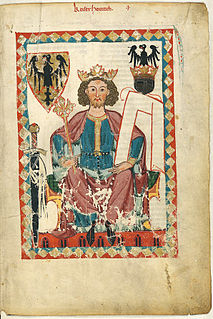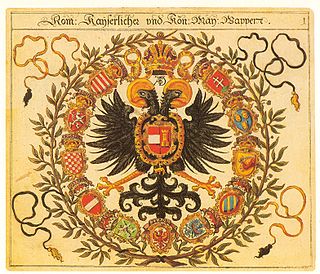 W
WOver its long history, the Holy Roman Empire used many different heraldic forms, representing its numerous internal divisions.
 W
WCodex iconographicus monacensis 236 is an armorial of the coats of arms of the attendants of the imperial diet of 1594 at Regensburg Rudolf II in 1594 declared Regensburg would be the sole location where imperial diets were to be held in the future.
 W
WThe flag of the Holy Roman Empire was not a national flag, but rather an imperial banner used by the Holy Roman Emperor; black and gold were used as the colours of the imperial banner, a black eagle on a golden background. After the late 13th or early 14th century, the claws and beak of the eagle were coloured red. From the early 15th century, a double-headed eagle was used.
 W
WAn Imperial State or Imperial Estate was a part of the Holy Roman Empire with representation and the right to vote in the Imperial Diet. Rulers of these Estates were able to exercise significant rights and privileges and were "immediate", meaning that the only authority above them was the Holy Roman Emperor. They were thus able to rule their territories with a considerable degree of autonomy.
 W
WThe Ingeram Codex is an armorial of the Holy Roman Empire made by Hans Ingeram for Albert VI, Archduke of Austria in 1459. It is largely concerned with the coats of arms of the Adelsgesellschaften fashionable at the time, a type of society or order formed by members of the lower nobility with the purpose of holding tournaments.
 W
WThe Reichsadler is the heraldic eagle, derived from the Roman eagle standard, used by the Holy Roman Emperors and in modern coats of arms of Germany, including those of the Second German Empire (1871–1918), the Weimar Republic (1919–1933) and Nazi Germany (1933–1945).
 W
WThe so-called Scheibler Armorial is an armorial manuscript compiled, in two separate portions, over the course of the 15th to 17th centuries. It is named for its first known private owners, the baronial Scheibler family of Hülhoven in the Rhineland.
 W
WSiebmachers Wappenbuch is a roll of arms first published in 1605 as two heraldic multivolume book series of armorial bearings or coats of arms of the nobility of the Holy Roman Empire, as well as coats of arms of city-states and some burgher families. Founded and compiled by Johann Ambrosius Siebmacher, a German heraldic artist, copperplate engraver, etcher and publisher from Nuremberg, these works became an important source of heraldry of the German-speaking regions.
 W
WThe Wernigerode Armorial is an armorial compiled in southern Germany in the late 15th century.
 W
WThe Zurich armorial is a roll of arms made in c. 1340 presumably in what is now eastern Switzerland ; it is now kept in the Swiss National Museum in Zurich.